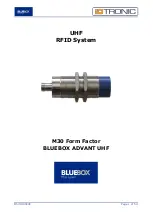
B5U033000E
Page 9 of 54
3
Operating Features
In ‘continuous’ mode the
BLUEBOX
is characterized by the coexistence of 2
‘parallel’ and asynchronous activities: the tag identification (inventory) and the
communication with the ‘host’ system. The ‘continuous’ identification activity
interacts with the communication activity through a buffer that contains the code
of the last identified tags or that is empty indicating the absence of tags. Due to
synchronization and filtering reasons, the buffer is handled for each identified
tag by a parameter defined as ‘hold time’ (same as ‘filter time’ defined below,
to be set in the range of 0 … 99 seconds or 0 ... 99 minutes, default value 1
second) and allows to extend ‘artificially’ the prese
nce of the tag after it leaves
the antenna’s influence area; this behavior is observable looking at the green
led status that is ‘on’ indicating the presence of tag. Through the
OD 2180h it is
possible to get the data contained in the buffer.
The
BLUEBOX
handles also a 32 elements FIFO queue which is combined with
the ‘filter time’ general parameter (to be set in a range of 0 … 99 seconds or 0
... 99 minutes, default value 1 second) that prevents the queue saturation in
case of a tag ‘continuous’ presence.
When a tag is identified, the
BLUEBOX
verifies if it belongs to the list of read tags. If the tag do not belong to the list
(it is defined as ‘new’), its code will be inserted in the queue, a filter time
assigned to the tag will be started. Otherwise (the tag belong to the list of read
tags), the
BLUEBOX
verifies if the relative filter time is expired. In this case
(the filter time is expired), the tag is defined as ‘new’ and will be processed as
described above, otherwise only the relative filter time will be rearmed. Through
the OD 2181h and 2182h, it is possible to get the data contained in the queue
and unload it.
Buffer and FIFO queue will hold onto a maximum of 82 bytes of tag
data. Once the 82 bytes of tag data limit is reached, the exceeded
bytes will be discarded!
The
BLUEBOX
allows the execution of ‘on request’ functions. During the
execution of these functions, the ‘continuous’ identification activity will be
suspended temporarily; the involved commands are relative to the read/write
specific activities of the supported transponders.
If not required, the
‘continuous’ identification activity can be disabled through a
flag defined in the parameters. In this case, the
BLUEBOX
will only execute the
‘on request’ commands already defined above.
‘
T
est’ mode
s are also defined:
•
‘RF Power’ test: allows the user to easily and quickly test the minimum RF
output power needed to read a tag in a fixed position. The reader sweeps









































